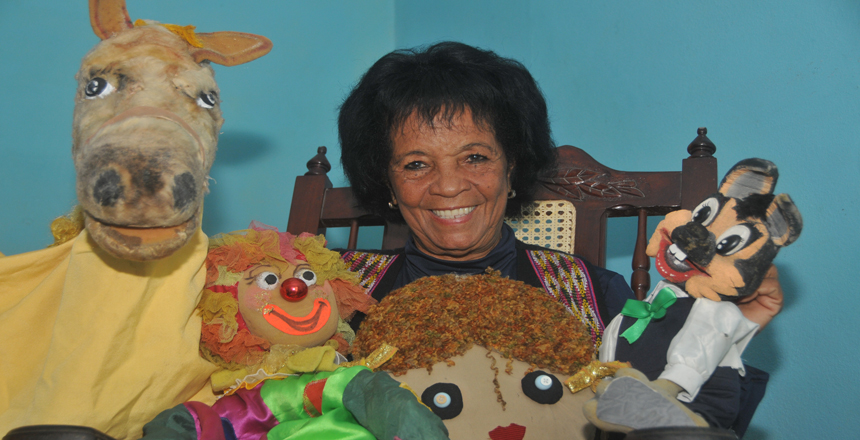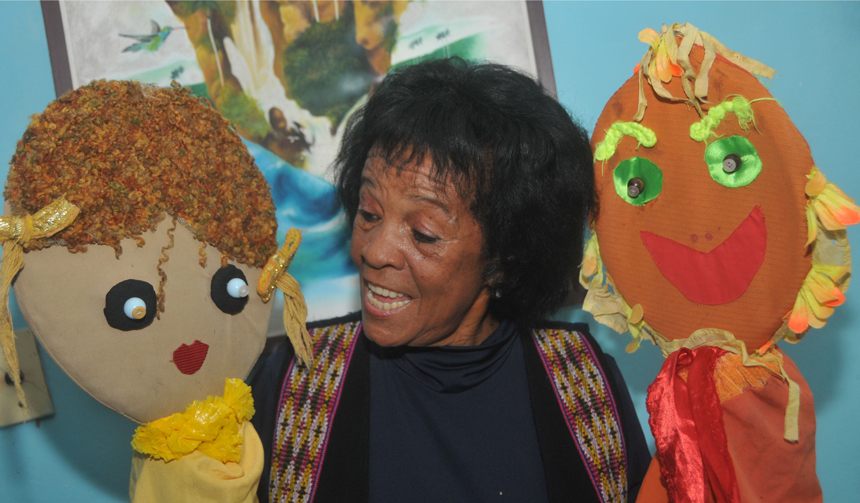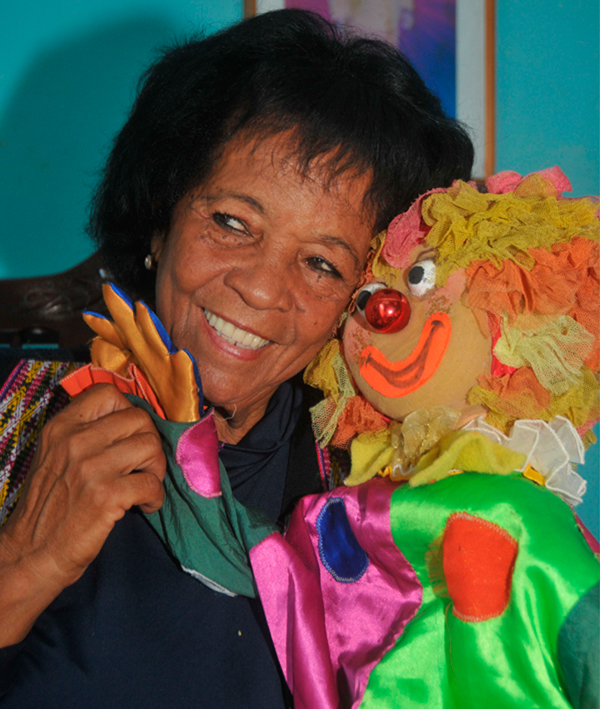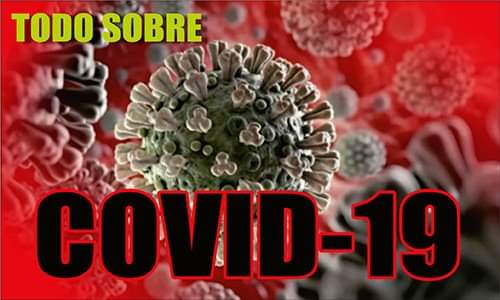
There, among puppets, we find her. Her eyes water as she talks about the passion of her life, the one she came to unwittingly and which has given us so much joy with the complicity of Caramelo or any other puppet. The actress Clotilde Aguillón, with a sweetness that goes beyond her ebony skin, agrees to the dialogue.
Let's talk about your childhood. How much did growing up in a family of musicians give you?
My father was a musician and violin teacher (Carlos Aguillón), and my mother (Alma Rodríguez) was a singing and piano teacher and choir director. I always liked singing. My sister Pilar and I formed the duo Las Aguillones, with whom we went to pioneer festivals, winning prizes. I grew up surrounded by artists.
I understand that you were all set to embark on a music career when a piece of news changed your destiny. Tell us that story.
As a child I took violin lessons and, at the age of 15, I went to the National School of Arts in Cubanacán, planning to study music, and I passed the aptitude exams. Then my sister Pilar came home saying that there was a school in Havana to study puppet theatre, the Escuela Nacional de Formación de Grupos de Teatro Guiñol, in Siboney. Our mother, with her strong character, told us: "You're going there". And I cried a lot, I wanted to study singing.

What do you remember about your time at that school?
I went along with other 13 people from Las Tunas, with Eloísa de Roble (teacher and cultural promoter) in charge of the group. But it wasn't all rosy. I was shy and had problems with my diction. I had to grow up. I said to myself: "If this is my career, I'm going to be good". And I learned I learned a lot. Besides, I had a luxury faculty. There we prepared two shows: El lindo ruiseñor and Juanito y la semilla. I grew fond of theatre. I graduated on 14 September 1971, very integral.
How did the Los Zahoríes Guignol come about and what were its first years?
The Guignol was the brainchild of the municipal departments of Culture and Education. The founders were Raúl Velázquez, José Chelala, Dulce María Rodríguez, Pilar Aguillón, and others, the same people who went to Havana. Juan José Rodríguez, although he didn't go with us, is a founder, as he helped form the group.
It was a beautiful period. In the beginning, we didn't have a venue and we performed at the Tomasa Varona Cultural Centre. We also did theatre for adults. We performed at the José Martí provincial library and other venues until we moved to the Raúl Gómez García theatre, which used to have other functions.
We presented El lindo ruiseñor and Juanito y la semilla in our headquarters. I was fascinated to see how it filled up, there were times when we gave two shows in a row. But we did not know about acting. At school, we were taught puppet animation. We learned along the way.
What is the most meaningful prize for you?
The biggest prize is the smiling face of a child. Although I have won several awards. I remember that just after graduating, I went with my classmates to the Festival de Grupos de Teatro Guiñol in Topes de Collantes, with Juanito y la Semilla. The play had a great impact because we were the puppeteers ourselves.
Then we went to a workshop in Santiago de Cuba and the play Zahoriada Primera, a version of the story El canto de la Cigarra (The Cicada's Song), was created. There I was recognized with the Live Performance Interpretation Award and the Puppet Performance Award.
You have left your mark on more than 300 works, which one has left the biggest impression on you?
Rocío de la mañana, a version I did of El cangrejo volador. I used as part of the set design a shell that came out of the bottom of the sea and the black light technique. A national commission was going around, selecting the shows that were going to the Havana International Theatre Festival, and they chose it. That's how I represented the puppet show. With that play, I also won the Acting Prize awarded by the Union of Writers and Artists of Cuba. Other plays have also left their mark on me.
Are children a difficult audience?
They are not difficult, but sincere and spontaneous. I have done projects with students who have special educational needs, such as Canturía a lo Guillén, which belongs to the Nicolás Guillén Foundation. And - to perform better - I have done a lot of research and even studied sign language.
I imagine that you treasure unforgettable experiences.
Yes, many. One day, when I finished performing at the Jesús Argüelles school, a child came up to me and asked: "Are you flesh and blood? On another occasion I went to a rural village in the municipality of Majibacoa and, at the end of the performance, another boy came up to me with a flower and said: "You are beautiful". That is indescribable.
How difficult is it to be a puppeteer?
Very difficult, there are several techniques. First, you feel the puppet and then you bring it to life. You stop being you, to be him. You have to respect that, the scene is sacred.
Among all the puppets, you have always preferred Caramelo, why?

Because he's a child who is mischievous, friendly, and cute. He always accompanies me.
Oral narration on stage is another of the areas you've cultivated...
I'm grateful to Verónica Hinojosa for pushing me in this direction. But I narrate with puppets and so I have participated in many important events.
You've also been interested in taking art to the community, why?
Some people don't go to theatres. The neighborhoods have a different audience. Culture is growing.
You shared with your sister Pilar your love for puppet theatre...
She was very good. She taught me to love theatre, to give myself, to be a companion, to dare to do things, to prepare my body.... I always honor her.
You have trained several actors. What parameters do you emphasize?
Being receptive. Never stop creating and studying. Respecting the audience and yourself. To have a sense of belonging, to study the character well, and to give more.
You worked in the Guignol for more than four decades and were part of the group Teatro Tuyo. How much did this last brotherhood contribute to you?
Those seven years with the troupe led by Ernesto Parra were a gift. There I continued to be an actress, but not a clown, but a puppeteer. I performed in the alternative room at his headquarters and communities; I taught Object Animation at the National School of Clowns and I was a tutor. I will always be grateful.
With 52 years of uninterrupted career and from your experience in puppetry, how do you evaluate the current performance of Los Zahoríes?
Guignol is alive, it is not dying as it used to. It's exciting to watch the new batch rehearsing, preparing... Although the venue is closed due to infrastructural problems, they look for alternatives and don't stop.
What is theatre for you?
My life.
...
This is the farewell of this first-class actress, honorary member of the International Union of Puppetry (UNIMA in Spanish) and UNEAC: "In the theatre, I have fulfilled my dreams as an artist, I feel complete", she said. And I, even happier, don't know whether to cry or laugh at such joy.





